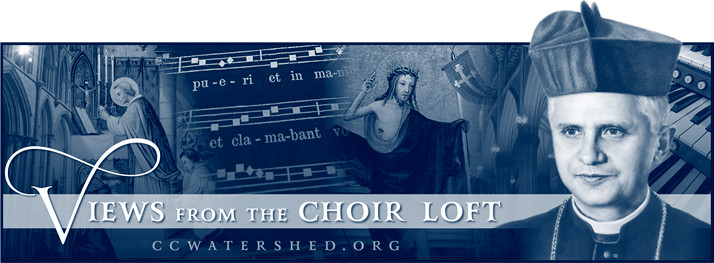
 CONTINUALLY struggle to understand the relationship between the treasury of sacred music (specifically the ordinary of the Mass) and Mass celebrated in the Ordinary Form, but a recent conversation with my pastor might shed a small ray of light on the subject from the perspective of the priest.
CONTINUALLY struggle to understand the relationship between the treasury of sacred music (specifically the ordinary of the Mass) and Mass celebrated in the Ordinary Form, but a recent conversation with my pastor might shed a small ray of light on the subject from the perspective of the priest.
In our parish, the congregation regularly sings the Mass XVI Kyrie along with a metrical setting of the rest of the Ordinary. However, after the Schola Cantorum returned from Rome last January, the choristers asked me before Mass if they could continue singing all of Mass IX (Cum jubilo), which they had sung at St. Peter’s. I decided it wouldn’t cause too much of a tizzy if the choir sang the Kyrie from Mass IX by themselves, so they sang it for the next few Sundays.
After several weeks the pastor asked me about it and in the nicest way possible told me he really didn’t care for it. I was a little taken aback simply because it was a very minor change to only one Mass of our Sunday Masses. I asked him if he could pinpoint for me what it was specifically about the Kyrie that bothered him in order for me to understand better. Was it the sound of Gregorian chant, or that the congregation couldn’t sing it, or that each invocation was repeated three times? His answer was something I had never thought of before. He told me that he felt extremely awkward standing in the sanctuary for two minutes while the congregation did nothing but look at him. I would be curious to know how this affects other priests.
It is true that in the Ordinary Form of the Mass the priest doesn’t face east during the Kyrie and Gloria, but if the priest were to change the direction of his chair so that he wouldn’t be directly facing the congregation (for example, facing liturgical north), it would help. A choral Sanctus or Agnus Dei might not be so awkward if the priest were facing east during the Eucharistic Prayer. He could even close his eyes and pray.
I realize that the obstacles to celebrating Mass ad orientem and restoring a tradition of good sacred music (both choral and congregational) are varied and numerous and I don’t want to simply a complex problem, but perhaps this is another facet to that problem.

Note from CCW President: The Cathedral in Corpus Christi, Texas, did exactly what Dr. Tappan suggests. The rector rotated the chairs precisely as he describes, and (for the record) it looked a lot better. Moreover, Pope Francis’ chief liturgical officer recently wrote the following:
Contrary to what has sometimes been maintained, it is in full conformity with the conciliar Constitution—indeed, it is entirely fitting—for everyone, priest and congregation, to turn together to the East during the penitential rite, the singing of the Gloria, the orations, and the Eucharistic prayer, in order to express the desire to participate in the work of worship and redemption accomplished by Christ. This practice could well be established in cathedrals, where liturgical life must be exemplary (cf. §41).
Many were surprised by this, because a “rigid” reading of the current Missal would not have the priest facing East for the GLORIA, as far as I know.

